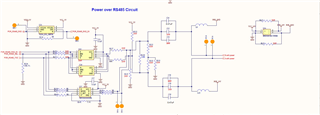Hi ,
I am using THVD8000 Driver IC for my new project to power nodes from gateway device over two wire.
The scope of project is
1. Gateway can have maximum of 3 nodes and minimum of 1 node connected on Power over RS485 bus at any point of time .
2. Gateway gets powered from 24V AC/DC powerline and rectifies this power to 24VDC which gets supplied to nodes over 2 wire.
3. A single node can consume maximum of 120mA from the bus (2.88W)
4. the cable used would be 18AWG untwisted, unshielded with maximum length of cable at 300ft .Cable part no's similar to below link will be used
5. The bus wires may run close to 230V power lines in conduits.
6. The nodes and gateway communicate at 9600 baud. The OOK carrier frequency is set to 130K
7. Attached is my circuit schematics, L8 and L10 are 2.2uH inductors(https://www.digikey.com/en/products/detail/bourns-inc/RLB1112V4-222J/6236173)

Please review the schematics and let me know of any improvisations required before prototyping.

